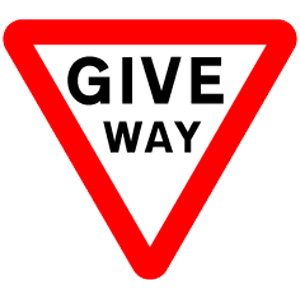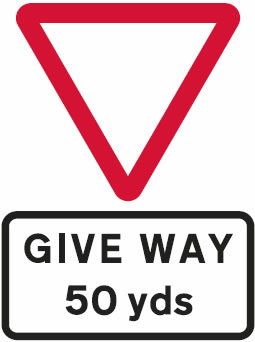Give way signs can be seen frequently throughout British roads and are used to warn motorists of an impending junction ahead. Give way signs are also regulatory signs that give an order.
Give way rules
Give way rules that a motorists facing a give way sign must give way to traffic on the road they intend to join.
The traffic on the road they intend on joining has priority and the motorists must wait for this traffic to pass and to wait for a suitable safe gap before joining the new road.
The triangle, red bordered sign with give way written in the centre is a regulatory sign giving an order.


Give way signs
Two types of give way signs are typically seen. A driver approaching a junction may see the give way warning sign – a blank triangle with red border and an information plate below the triangle providing details of the potential hazard ahead. Distance to the junction is in yards and can vary in distance.
Give way warning signs are typically used where they junction may be difficult to see, as it could be on a bend for instance. At the junction the regulatory give way sign may be seen where the driver must give way to traffic before entering the new road.
Why are give way signs upside down
The equilateral give way sign is upside down compared to other warning road signs simply as a recognition of shape. So if for instance a give way sign was to become defaced due to snow for example, the shape of the sign alone would be enough to inform a motorist of the impending hazard (a junction) that is ahead.
Give way road markings and lines
You have probably seen these road markings before and perhaps asked ‘what does the triangle road marking mean’? The upside down triangle markings on the road represent a warning to motorists that there is a give way just ahead. The triangle road marking along with the lines representing where the vehicle must stop and wait if necessary to give way are often placed at a minor junction, particularly where it meets a major road where there is a difference in traffic speed and volume on the two roads. For further information, see:
Should you stop at a give way sign?
Unlike a stop sign, you are not legally obliged to do so. Whether you stop or not however depends on the type of junction. Not all types of junction have give way signs or road markings. Quiet junctions may have no signs or road markings at all, large busy junction may be controlled by traffic lights. One of the most important aspects of a junction is to establish if it is open or closed.
How to approach a give way sign
Approach a give way junction using the Mirror Signal Manoeuvre routine (MSM), or better still the MSPSL routine. This is expected by the driving examiner during the driving test. To establish whether you need to stop or proceed without stopping, you must assess whether the junction is open or closed.
A closed junction restricts your view of the road and traffic on the road you intend on joining, and open junction is clear to see and determine whether you must stop or proceed. See junctions for further information and a full explanation on open and closed junctions.
Difference between give way and stop sign
Both give way and stop signs are regulatory order signs. The difference between give way and stop signs however is at a stop sign, a motorist must legally stop just before the stop line before proceeding. This is often due to the area that the motorist intends on entering is highly hazardous. Give way rules are different in that the driver must give way to traffic ahead but do not need to stop if it is determined that it is safe to proceed without doing so.

Accurate answer
There is no clear guidance on the question of what parts of a vehicle may be over give way lines, should one stop with the front of the vehicle behind or over the lines and the wheels still behind the lines? Is it acceptable for part of a vehicle on the major road to enter the area over the lines when using a roundabout?
Hi John,
It’s all about the very front of the vehicle, not the wheels. The examiner will expect you to stop your car at junctions lines so that the front is not in the road you intend on joining as this may cause a hazard to vehicles on the road. It will be acceptable for the front of your vehicle to be on the give way lines, but not ahead, into the new road. The only exception could be when attempting to emerge from a closed/blind junction where you would need to creep forwards very slowly.